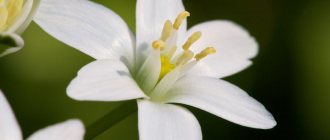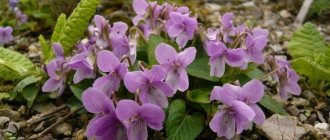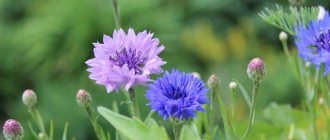Save our selection of the most common types and varieties of phlox in cultivation. We are sure that you will certainly find something for your garden in it!
Phlox are delightful flowers that amaze with a variety of shapes, sizes and shades. Among them there are bush and ground cover species, both spring and summer flowering. You can choose a variety with snow-white or variegated flowers. Whatever type or cultivar you choose, you can be sure of one thing - phlox will not disappoint you.
Phlox paniculata
This is perhaps the most common type of phlox, which can be found in almost every flower garden. It blooms all summer until early autumn, striking in color and filling the garden with a pleasant sweet aroma.
Paniculate phloxes are indispensable for misborders and borders. They can be safely planted in the most visible place, without worrying that the flowers will fade due to the heat and scorching sun. On the other hand, they bloom no less luxuriantly even in light shade.
It is important to consider that for good growth, paniculate phlox need good air circulation, so you should not plant them close to buildings. These plants should never be mulched in the summer.
Wherever you place this phlox bushes, you can be sure that bees and butterflies will constantly be circling around.
This is a bush type of phlox, which belongs to the tall group. Panicle phlox grow up to 1.2 m in height depending on the variety and prefer moderate watering and well-drained soil.
Amethyst
Spectacular phlox of medium height with fragrant inflorescences of a bluish-purple hue.
| Petal coloring | Bush height (cm) | Bush width (cm) | Flowering time |
| Bluish-purple | 80-90 | 30-60 | July August |
Blue Paradise
Blue Paradise is a paniculate phlox with charming bluish-lavender flowers that exude a pleasant light aroma. This cultivar is considered tall.
| Petal coloring | Bush height (cm) | Bush width (cm) | Flowering time |
| Bluish-lavender | 90-120 | 30-60 | July August |
Bright Eyes
A charming medium-growing phlox with a strong aroma. It is not afraid of fungal diseases and is unlikely to cause you any trouble in caring for it.
| Petal coloring | Bush height (cm) | Bush width (cm) | Flowering time |
| Soft pink | 45-60 | 30-60 | July August |
David
Luxurious snow-white phlox David received a prestigious award from British flower growers. This stately beauty grows well both in the sun and in partial shade, and practically does not get sick.
| Petal coloring | Bush height (cm) | Bush width (cm) | Flowering time |
| Snow-white | 90-120 | 30-60 | July August |
Delilah
A low plant with pinkish-purple flowers. Phlox varieties Delila are generally not capricious and resistant to various kinds of diseases, but can sometimes be susceptible to spotting.
| Petal coloring | Bush height (cm) | Bush width (cm) | Flowering time |
| Magenta | 50-60 | 30-50 | July-September |
Candy Twist
Candy Twist is a variety of paniculate phlox with playful striped colors reminiscent of a candy cane. This phlox is very fragrant, does not fade in the sun, and is disease resistant.
| Petal coloring | Bush height (cm) | Bush width (cm) | Flowering time |
| White and pink stripes | 45-60 | 60-70 | July-September |
Sandro Botticelli
A delightful variety of phlox selected by Yuri Reprev is deservedly named after the great Italian painter. Sandro Botticelli delights with its delicate lilac-pink color. You'd think it came straight from an artist's canvas.
| Petal coloring | Bush height (cm) | Bush width (cm) | Flowering time |
| Mauve | 70-75 | 60-70 | July August |
How to grow this variety of phlox and how to care for it
Landing location
. The plant will not bring with it any special worries if you wisely choose the conditions for its living. For example, a suitable planting site for Phlox sibirica is open, and preferably slightly elevated.
I chose an excellent planting site for phlox - a stump
. Moisture-loving phlox reacts negatively to stagnant water. He prefers watering, but not completely soaking the roots. Then he dies. The plant cannot tolerate the proximity of the root system of trees and powerful bushes. In this case, stronger plants will select the moisture and light necessary for comfortable growth and development of phlox.
If there is no suitable place, you can create it by arranging a high bed, clearing an area of “adult” plants, or simply draining the soil.
Planting pit
. When planting, it is important to remember that the roots of the plant are superficial, and therefore you should not make the hole very deep. 30cm is enough. this is enough to arrange several layers:
- broken brick or crushed stone,
- sand,
- sand with organic fertilizers,
- fertilizers with soil.
And now you can water the hole with 3-5 liters of water and place the seedlings in it while the water has not yet been completely absorbed.
Boarding time
. I planted my bushes in the spring. And they all took one hundred percent action and bloomed conscientiously. Now they are more than two years old. They survived the winters safely. This is why I can confidently recommend early spring planting.
However, autumn planting also has a number of advantages. For example, the bush completely focuses on acclimatization, without wasting energy on flower buds. If you choose a time when there is just a whiff of coolness, then before the cold weather begins, the phlox can easily take root in this place.
Preparing Phlox sibirica for frost
. It easily tolerates winters if you lightly brush the bush with organic matter or sawdust (preferably both) to protect the roots that are close to the surface. In this case, there is no need to fertilize the plant in the spring. And the bush blooms longer and more beautifully in this case.
Phlox in autumn
Fertilizing the plant
. It is advisable to feed phlox at least once a week throughout the summer. And, if in early spring they choose organic matter for this, then starting from flowering you need to take special mineral supplements. Fertilizing is tedious after a day of watering. And it is advisable to choose the evening time for this, closer to sunset.
Diseases and pests of phlox
. I encountered threats to my phlox from slugs, spider mites and aphids. I successfully fight slugs with eggshells and mulching around the bush with sawdust. I bought special products for aphids and mites – insecticides.
Watering
. I’ve already said a lot about watering, but it remains to add that it should be completely eliminated if it rains well at least once a week. Or, if the summer turns out to be cool, then watering is reduced to 2 times a month.
Plant propagation
. Personally, I have so far tried to propagate my phloxes only by dividing the bush. But I know that Phlox sibirica can be propagated by cuttings, both root and stem, as well as seeds.
Phlox feels great in combined flower beds
Spotted Phlox (Phlox maculata)
Spotted phlox is also often called meadow or pyramidal phlox. This is a very close relative of Phlox paniculata. You can distinguish spotted phlox from its more popular “brother” by two features: small burgundy spots on the stem and the pyramidal shape of the inflorescences.
Like other phloxes, plants of this species love moist, fertile soil and well-lit or partially shaded areas. It is worth considering that, unlike paniculate phloxes, spotted phloxes often suffer from powdery mildew and are susceptible to nematodes and spotting.
- Phlox diseases and their treatment
What diseases most often affect phlox, and how to deal with them?
Spotted phlox is not inferior in beauty to paniculata phlox, but not so many varieties have been bred.
Delta
One of the most common, proven varieties of spotted phlox.
| Petal coloring | Bush height (cm) | Bush width (cm) | Flowering time |
| Pinkish-white with a bright pink eye | 70-80 | 45-50 | July August |
Natasha
Natasha is one of the most famous varieties of spotted phlox. This is a beautiful pink and white striped flower. However, Natasha is a rather capricious little thing.
This phlox grows much slower than other cultivars of this species, and in bright sun it can fade, so it is advisable to plant it in partial shade.
| Petal coloring | Bush height (cm) | Bush width (cm) | Flowering time |
| Hot pink and white stripes | 70-80 | 40-50 | July August |
Omega
Phlox Omega is a worthy, beautiful, unpretentious flower for the garden. It can withstand temperatures below –20°C and grows quickly.
| Petal coloring | Bush height (cm) | Bush width (cm) | Flowering time |
| Snow-white with pinkish-purple eye | 80-90 | 40-50 | July August |
Rosalind
The Rosalind variety is about to turn one hundred years old - this flower has been grown in gardens since 1920. It usually blooms a couple of weeks earlier than most phloxes.
The only “cosmetic” drawback of the Rosalind phlox can be considered an insufficiently lush inflorescence. Therefore, it is usually planted in the background of mixborders.
| Petal coloring | Bush height (cm) | Bush width (cm) | Flowering time |
| Hot pink | 90-130 | 40-50 | End of June – August |
Features of growing phlox as a perennial garden crop
Phloxes look good as single plantings, as well as in combination with astilbe, marigolds or cosmos
The main thing to keep in mind when growing perennial phlox is that they will bloom only in the second year after they were planted in the ground. According to the timing of flowering, three groups of plants are distinguished:
- early (flowers appear from May to mid-summer);
- average (July - end of August);
- late (flowering lasts from August until frost).
The duration of flowering varies among different varieties: some phlox bloom for 1 month, others for 2–2.5 months, and others enter the flowering phase twice per season. By wisely combining varieties, it is possible only with the help of these flowers to create the illusion of constant flowering in the garden - from spring to the first cold weather.
It is best to grow phlox in open ground. It is important that the place is sunny and protected from the winds. If you need to place perennial phlox under trees or shrubs, you need to select shade-loving varieties.
But in flowerpots and tubs this plant does not feel the best, and all because the limited space of the container does not allow maintaining constant heat and humidity that is comfortable for the flower: on sunny days, phlox leaves quickly begin to wither, even if the flowers are watered twice a day .
What climate is this plant suitable for?
Phlox grows best on loam or fertile sandy loam.
Perennial phlox can be grown in any climatic zone of Russia. However, if we are talking about territories with a sharply continental climate - the Urals, Siberia, Altai, where the average July temperatures are +18°C, and in January drop to an average of -18°C (on the coldest days the temperature can reach - 50°C), you need to focus on varieties with early flowering periods. For winter in these regions, plants need to be thoroughly prepared - covered with non-woven material, in several layers, or sprinkled with peat.
Phlox is much more comfortable in the European part of Russia: already in May the average maximum temperature is +19°C, in July it is +23°C and in September +18°C. Winter indicators are in the range of –8…–13°C
An important nuance: phlox should not be planted in lowlands and areas where groundwater is very close. The best option for placing a flower garden would be a small hill.
The soil requirements are as follows: it must be sufficiently loose and nutritious. It is good if it is loamy soil that gives a neutral or slightly acidic reaction (optimal pH values are from 5.5 to 7.0). If it is not possible to allocate such an area for phlox and the soil is too acidic, the best solution is liming. Among fertilizers, the flower responds well to compost, manure, and wood ash.
Phlox divaricata
Phlox spreada is native to North America and is often called Phlox canadensis. Other names for this plant are forest phlox or wild blue phlox.
This is a medium-sized plant that is very different from the previous two types of phlox. The height of the splayed phlox is 20-50 cm. The color scheme of the petals is bluish-lilac, in delicate pastel colors.
This phlox loves well-fertilized soil, but at the same time is perfect for rockeries and rocky areas. It also has a strong sweet aroma and attracts many bees and butterflies.
Not many varieties of this perennial are grown in cultivation, but all of them are 100% worth the time and effort invested in caring for them.
Clouds of Perfume
Phlox Clouds of Perfume forms a turf up to 60 cm wide. In spring, it is dotted with a scattering of charming lavender flowers that fill the flower garden with their aroma.
Please note that this phlox is not resistant to powdery mildew and nematodes.
| Petal coloring | Bush height (cm) | Bush width (cm) | Flowering time |
| Lavender | 20-30 | 50-60 | April May |
Landen Grove (London Grove)
From a distance, the Landen Grove phlox bushes can be mistaken for a sea of forget-me-nots. But if you come a little closer, you will be covered with a cloud of subtle aroma that cannot be confused with anything else.
This perennial is quite resistant to powdery mildew, grows well and does not require special care.
| Petal coloring | Bush height (cm) | Bush width (cm) | Flowering time |
| Bluish-lavender | 30-35 | 50-60 | April May |
Fuller's White
White bushes of Fullers White will be an excellent decoration for a spring mixborder.
This phlox is notable for its excellent winter hardiness - it can withstand frosts down to –40°C.
| Petal coloring | Bush height (cm) | Bush width (cm) | Flowering time |
| White with a slight purple tint | 30-35 | 15-30 | April May |
Eco Texas Purple
Phlox Eco Texas Purple is notable for its spectacular dark lilac flowers. It differs from most spreading phlox cultivars in its later flowering period - from late spring to early summer.
| Petal coloring | Bush height (cm) | Bush width (cm) | Flowering time |
| Purple with pink eye | 30-35 | 15-30 | May June |
Botanical description of the species
Phlox paniculata is a perennial herbaceous plant 35-150 cm tall. Most varieties form bushes 60-70 or 80-100 cm high. It must be remembered that this parameter changes depending on the light intensity. In bright sun the plants turn out lower, but even two hours of midday shading increases their height. The stems are very strong, straight, and become woody towards the end of the growing season.
There is no yellow in the color palette of paniculata phlox. This pigment is also absent in the group of so-called red varieties. Their color is dominated by crimson color of varying saturation of both warm and cold tones. Therefore, in the descriptions there are such definitions as red-pink, red-lilac, light orange-red, purple-red, etc. The situation is similar in the orange or salmon group. These tones are very unique and complex, they also come in varying intensities with the addition of pink and carmine.
Phlox stolonifera
Phlox stoloniferous is a ground cover species that is often called creeping phlox. Its homeland is the American Appalachians, so it is accustomed to harsh climates and is ultra-winter-hardy.
Like other phloxes, perennials of this species grow well in moist, humus-rich soils and love rocky areas.
Phlox stoloniferous grows quickly, forming dense mats up to 20 cm high. It practically does not get sick, does not have any special care requirements, and prefers partial shade.
Breeders have managed to develop few varietal stoloniferous phloxes, but they pleasantly surprise with their variety of colors.
Bruce's White
Bruce White is a variety of white-flowered phlox stoloniferous. Its flowering occurs in mid to late spring. This is a “titled” phlox that received a prestigious award from American breeders.
| Petal coloring | Bush height (cm) | Bush width (cm) | Flowering time |
| Snow-white | 15-20 | 20-60 | April May |
Home Fires
The bright pink phlox Home Fires does not mind good lighting and does not fade in direct sunlight. It prefers moderate moisture, but can easily be considered a drought-resistant perennial.
| Petal coloring | Bush height (cm) | Bush width (cm) | Flowering time |
| Pink | 15-20 | 20-60 | April May |
Sherwood Purple
Phlox Sherwood Purple will add bright colors to a shaded corner of the garden. Feel free to plant it in the tree trunks of trees and large shrubs - it quickly forms a fluffy purple-green mat.
| Petal coloring | Bush height (cm) | Bush width (cm) | Flowering time |
| Bluish-purple | 15-20 | 20-60 | July August |
Phlox care
To ensure that phloxes do not lose their decorative properties for as long as possible, you need to follow a few simple care recommendations. This is not as difficult as is commonly believed, because the main thing is more watering and nutrition.
Temperature and lighting
Choose sunny or semi-shaded areas for phlox, because in the shade they bloom worse, quickly fade and become inconspicuous. Plants love warmth and do not tolerate strong winds and drafts. Tall bushes may be damaged by sudden gusts or rainstorms.
Watering
Abundant watering is a vital necessity for phloxes, otherwise they begin to dry out and crumble. To keep moisture in the ground longer, carefully mulch the soil. Regular moistening is the main requirement if you want phlox to bloom almost until autumn.
Phlox subulata
Flowers of this species boast the most luscious colors among all low-growing phloxes. They come in bright pink, lavender, lilac, crimson, red, purple, snow-white and even variegated. In a word, for every taste and color.
Subulate phloxes do not require special care, do not cause problems, do not get sick, and quickly grow into dense, voluminous mats.
It is best to plant them in well-lit areas. They are suitable for rock gardens and rock gardens and require well-drained soil.
The height of the awl-shaped phlox bushes does not exceed 15 cm. This is the shortest phlox that is grown in cultivation.
Bonita
This phlox is not afraid of the most severe frosts and sweltering heat. Its bright pink flowers will brighten any border along a garden path.
| Petal coloring | Bush height (cm) | Bush width (cm) | Flowering time |
| Pink with purple eye | 10-15 | 45-60 | July August |
Candy Stripes
Candy Stripes is one of the most variegated varieties of awl-shaped phlox. Its petals have a distinctive bright pink stripe in the center, a white border around the edges and a dark purple spot at the base.
Like other subulate phloxes, this cultivar is frost-hardy and loves good light and well-drained soil.
| Petal coloring | Bush height (cm) | Bush width (cm) | Flowering time |
| White and pink stripes with a purple eye | 10-15 | 60 | May June |
Phlox after flowering
Annual phlox may bloom next year, but the quality of the inflorescences is unlikely to be high. Therefore, collect the seeds if you want, cut off the tops that have dried in the fall, and dig up the soil on the site, removing the phlox rhizomes from it. In the spring, you can sow the collected seeds, and the flowers you like will bloom again.
In the photo: Phlox blooming in the garden
Wintering phlox
Perennial phloxes, or rather, their growth buds, can freeze out in a snowless winter if the temperature drops to -10-15 ºC, and if the frost reaches -20-25 ºC, the rhizome of the phlox will die. Therefore, in the fall, after the phlox tops have turned yellow and dried out, cut them off and sprinkle the root collars with a layer of soil with peat. Cover them with straw, fallen leaves or spruce branches to keep the rhizomes in the ground until spring. If snow falls 50-60 cm thick, then you don’t have to be afraid of thirty-degree frosts.
Pest and disease control
The most serious and common problem with phlox is nematodes, and they do best in areas where flowers have been grown in one place for many years. Other pests are much less of a nuisance, but you may encounter thrips, caterpillars, cutworms and broncos. Timely treatment with insecticides helps all of them.
Viruses can cause serious damage to phlox - mosaic, spotting, dwarfing or shredding. They cannot be treated, so the affected flowers will have to be destroyed as soon as possible. Most of these viruses are carried by parasitic insects, so seasonal prevention is your best assistant.
Annuals
Among the abundance of different species of the phlox family, there are many perennial representatives and only one annual - the Drummond phlox, named after the botanist who brought it from America to Europe 300 years ago. The latter is the most outstanding in beauty, but also the most picky about climatic conditions and more demanding in terms of maintenance.
The annual species has about a dozen varieties, radically different from each other in color and shape. Sometimes it’s even hard to believe that these flowers belong to the same species. The panicles of inflorescences are dense and sparse. The diameter of each flower does not exceed 20 mm, but the panicles themselves reach up to 150 mm in diameter.
The colors of the petals have a wide range: from bright, variegated to various combinations and shades. In this case, contrasts between the middle and edges of the petals and smooth gradient transitions are often observed.
This species is characterized by a variety of petals: from round to star-shaped with fringe. With proper care, the density of flowers creates a crown that completely covers the stem and leaves, creating the illusion of unity of all the flowers in the inflorescence. In central Russia, this phlox blooms from late spring until October and is destroyed only by the first frosts.
Landing
By the time of planting, the soil should have a sufficient supply of moisture.
If the weather before planting is warm and there is no rain, then the area immediately before planting is watered abundantly. After drying, the soil is loosened with cultivators to a depth of 12–15 cm. Planting is carried out using one-, two- or three-line tapes. The distance between the tapes is 60–80 cm, between the lines in the tape 35–50 cm, and between plants 30–40 cm. When landscaping the area, phlox is planted in clumps, but no more than six plants per 1 m2.
When planting, the roots of the rhizomes are straightened, and they try to plant the division so that after compaction and settlement of the soil, the formed eyes are buried no more than 4–5 cm. When planted deep, the plants develop worse. With a higher location of the division, the base of the developing stem and the vegetative buds that form on it will be at soil level and damaged by low winter temperatures.
At the same time, well-developing spring cuttings are also planted. Cuttings from summer harvesting periods are planted in a permanent place the following year.
Border perennials - types of low-growing flowers, care rules. Press!
| galanthus, pushkinia, tulip, narcissus, muscari | up to 15 cm; up to 15 cm; 10-40 cm; 7.5-40 cm; 10-30 cm | March; April May; April May; April June; April June | |
| ground cover | subulate phlox, spreading phlox, periwinkle, creeping tenacious, sedum, grass carnation | 5-10 cm; 20-30 cm; 20-30 cm; 15-25 cm; 15-20 cm; 10-15 cm | April May; May June; May June; May June; June July; June-September |
| herbaceous low-growing | bergenia, primrose, gravilat, lavender jagged, chrysanthemum border | up to 40 cm; 15-20 cm; 15-30 cm; up to 30 cm; up to 30 cm | March, April; April May; May-July; May-August; September October |
| low growing shrubs | Japanese spirea, border rose, lingonberry, dwarf barberry | 20-40 cm; 15-40 cm; 8-15 cm; up to 40 cm | July August; June-September; May June; May June |
In the garden , as a rule, there are open and shaded areas. Therefore, when choosing border plants, you should take into account their light-loving nature.
Feels good in the shade The sun's rays are useful for aquilegia, heuchera, speedwell, daffodils, tulips, pinnate carnation, etc.
Tip: when planting plants along the paths, you should step back a little from the edge so that leaves and flower stems do not interfere with free passage.











